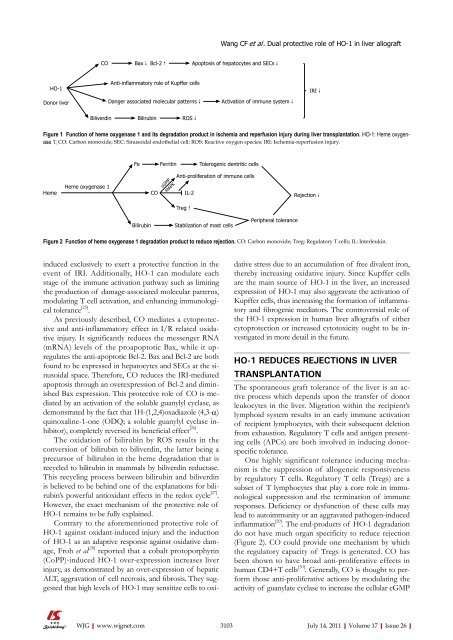26 - World Journal of Gastroenterology
26 - World Journal of Gastroenterology
26 - World Journal of Gastroenterology
Create successful ePaper yourself
Turn your PDF publications into a flip-book with our unique Google optimized e-Paper software.
HO-1<br />
Donor liver<br />
CO<br />
induced exclusively to exert a protective function in the<br />
event <strong>of</strong> IRI. Additionally, HO-1 can modulate each<br />
stage <strong>of</strong> the immune activation pathway such as limiting<br />
the production <strong>of</strong> damage-associated molecular patterns,<br />
modulating T cell activation, and enhancing immunological<br />
tolerance [25] .<br />
As previously described, CO mediates a cytoprotective<br />
and anti-inflammatory effect in I/R related oxidative<br />
injury. It significantly reduces the messenger RNA<br />
(mRNA) levels <strong>of</strong> the proapoptotic Bax, while it upregulates<br />
the anti-apoptotic Bcl-2. Bax and Bcl-2 are both<br />
found to be expressed in hepatocytes and SECs at the sinusoidal<br />
space. Therefore, CO reduces the IRI-mediated<br />
apoptosis through an overexpression <strong>of</strong> Bcl-2 and diminished<br />
Bax expression. This protective role <strong>of</strong> CO is mediated<br />
by an activation <strong>of</strong> the soluble guanylyl cyclase, as<br />
demonstrated by the fact that 1H-(1,2,4)oxadiazole (4,3-α)<br />
quinoxaline-1-one (ODQ; a soluble guanylyl cyclase inhibitor),<br />
completely reversed its beneficial effect [<strong>26</strong>] .<br />
The oxidation <strong>of</strong> bilirubin by ROS results in the<br />
conversion <strong>of</strong> bilirubin to biliverdin, the latter being a<br />
precursor <strong>of</strong> bilirubin in the heme degradation that is<br />
recycled to bilirubin in mammals by biliverdin reductase.<br />
This recycling process between bilirubin and biliverdin<br />
is believed to be behind one <strong>of</strong> the explanations for bilirubin’s<br />
powerful antioxidant effects in the redox cycle [27] .<br />
However, the exact mechanism <strong>of</strong> the protective role <strong>of</strong><br />
HO-1 remains to be fully explained.<br />
Contrary to the aforementioned protective role <strong>of</strong><br />
HO-1 against oxidant-induced injury and the induction<br />
<strong>of</strong> HO-1 as an adaptive response against oxidative damage,<br />
Froh et al [28] reported that a cobalt protoporphyrin<br />
(CoPP)-induced HO-1 over-expression increases liver<br />
injury, as demonstrated by an over-expression <strong>of</strong> hepatic<br />
ALT, aggravation <strong>of</strong> cell necrosis, and fibrosis. They suggested<br />
that high levels <strong>of</strong> HO-1 may sensitize cells to oxi-<br />
WJG|www.wjgnet.com<br />
Bax↓ Bcl-2↑<br />
Anti-inflammatory role <strong>of</strong> Kupffer cells<br />
Danger associated molecular patterns↓<br />
Biliverdin Bilirubin ROS↓<br />
Apoptosis <strong>of</strong> hepatocytes and SECs↓<br />
Activation <strong>of</strong> immune system↓<br />
Figure 1 Function <strong>of</strong> heme oxygenase 1 and its degradation product in ischemia and reperfusion injury during liver transplantation. HO-1: Heme oxygenase<br />
1; CO: Carbon monoxide; SEC: Sinusoidal endothelial cell; ROS: Reactive oxygen species; IRI: Ischemia-reperfusion injury.<br />
Heme<br />
Heme oxygenase 1<br />
Fe Ferritin Tolerogenic dentritic cells<br />
CO<br />
cGMP<br />
MAPK<br />
Anti-proliferation <strong>of</strong> immune cells<br />
IL-2<br />
Treg↑<br />
Bilirubin Stablization <strong>of</strong> mast cells<br />
Wang CF et al . Dual protective role <strong>of</strong> HO-1 in liver allograft<br />
Peripheral tolerance<br />
Figure 2 Function <strong>of</strong> heme oxygenase 1 degradation product to reduce rejection. CO: Carbon monoxide; Treg: Regulatory T cells; IL: Interleukin.<br />
IRI↓<br />
Rejection↓<br />
dative stress due to an accumulation <strong>of</strong> free divalent iron,<br />
thereby increasing oxidative injury. Since Kupffer cells<br />
are the main source <strong>of</strong> HO-1 in the liver, an increased<br />
expression <strong>of</strong> HO-1 may also aggravate the activation <strong>of</strong><br />
Kupffer cells, thus increasing the formation <strong>of</strong> inflammatory<br />
and fibrogenic mediators. The controversial role <strong>of</strong><br />
the HO-1 expression in human liver allografts <strong>of</strong> either<br />
cytoprotection or increased cytotoxicity ought to be investigated<br />
in more detail in the future.<br />
HO-1 REDUCES REJECTIONS IN LIVER<br />
TRANSPLANTATION<br />
The spontaneous graft tolerance <strong>of</strong> the liver is an active<br />
process which depends upon the transfer <strong>of</strong> donor<br />
leukocytes in the liver. Migration within the recipient’s<br />
lymphoid system results in an early immune activation<br />
<strong>of</strong> recipient lymphocytes, with their subsequent deletion<br />
from exhaustion. Regulatory T cells and antigen presenting<br />
cells (APCs) are both involved in inducing donorspecific<br />
tolerance.<br />
One highly significant tolerance inducing mechanism<br />
is the suppression <strong>of</strong> allogeneic responsiveness<br />
by regulatory T cells. Regulatory T cells (Tregs) are a<br />
subset <strong>of</strong> T lymphocytes that play a core role in immunological<br />
suppression and the termination <strong>of</strong> immune<br />
responses. Deficiency or dysfunction <strong>of</strong> these cells may<br />
lead to autoimmunity or an aggravated pathogen-induced<br />
inflammation [29] . The end-products <strong>of</strong> HO-1 degradation<br />
do not have much organ specificity to reduce rejection<br />
(Figure 2). CO could provide one mechanism by which<br />
the regulatory capacity <strong>of</strong> Tregs is generated. CO has<br />
been shown to have broad anti-proliferative effects in<br />
human CD4+T cells [30] . Generally, CO is thought to perform<br />
those anti-proliferative actions by modulating the<br />
activity <strong>of</strong> guanylate cyclase to increase the cellular cGMP<br />
3103 July 14, 2011|Volume 17|Issue <strong>26</strong>|

















